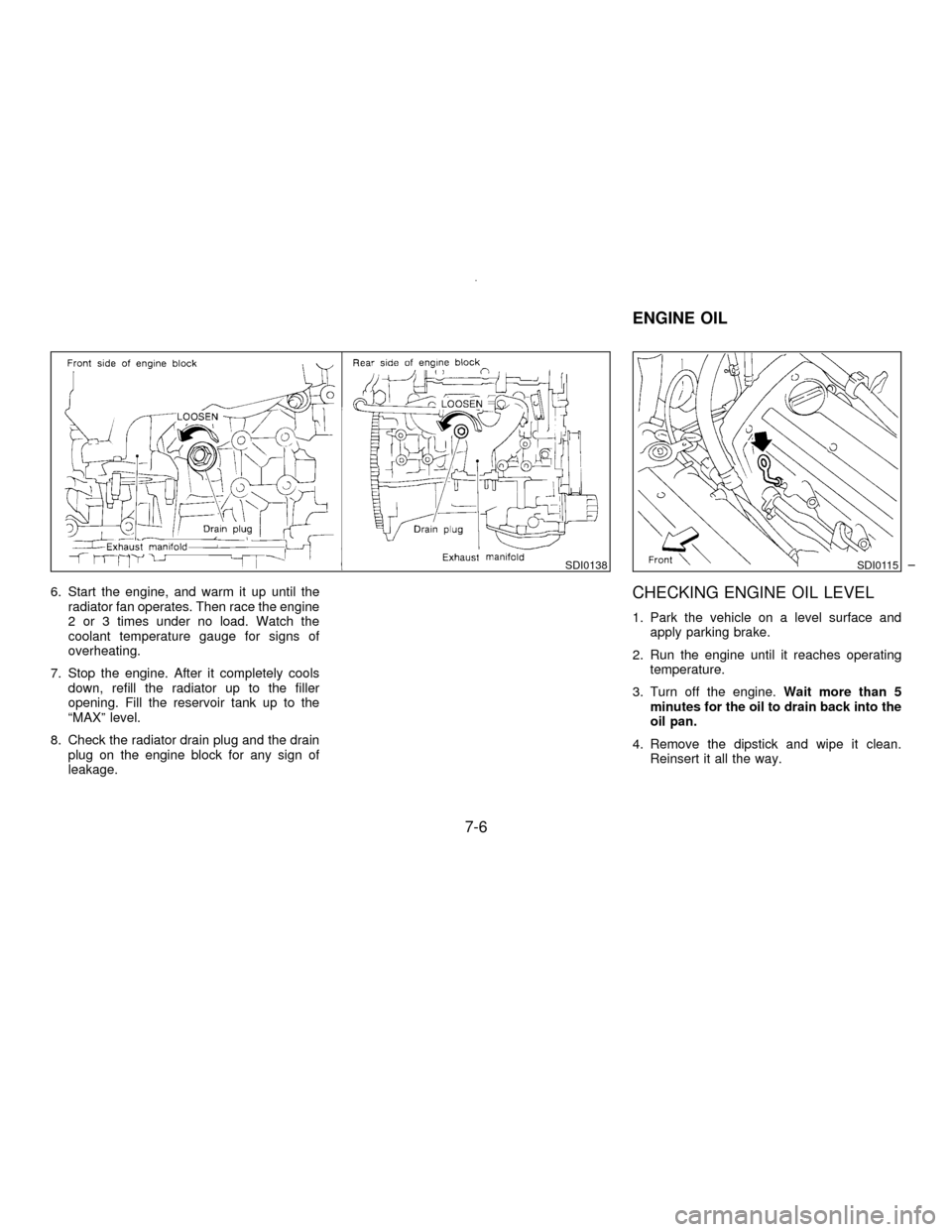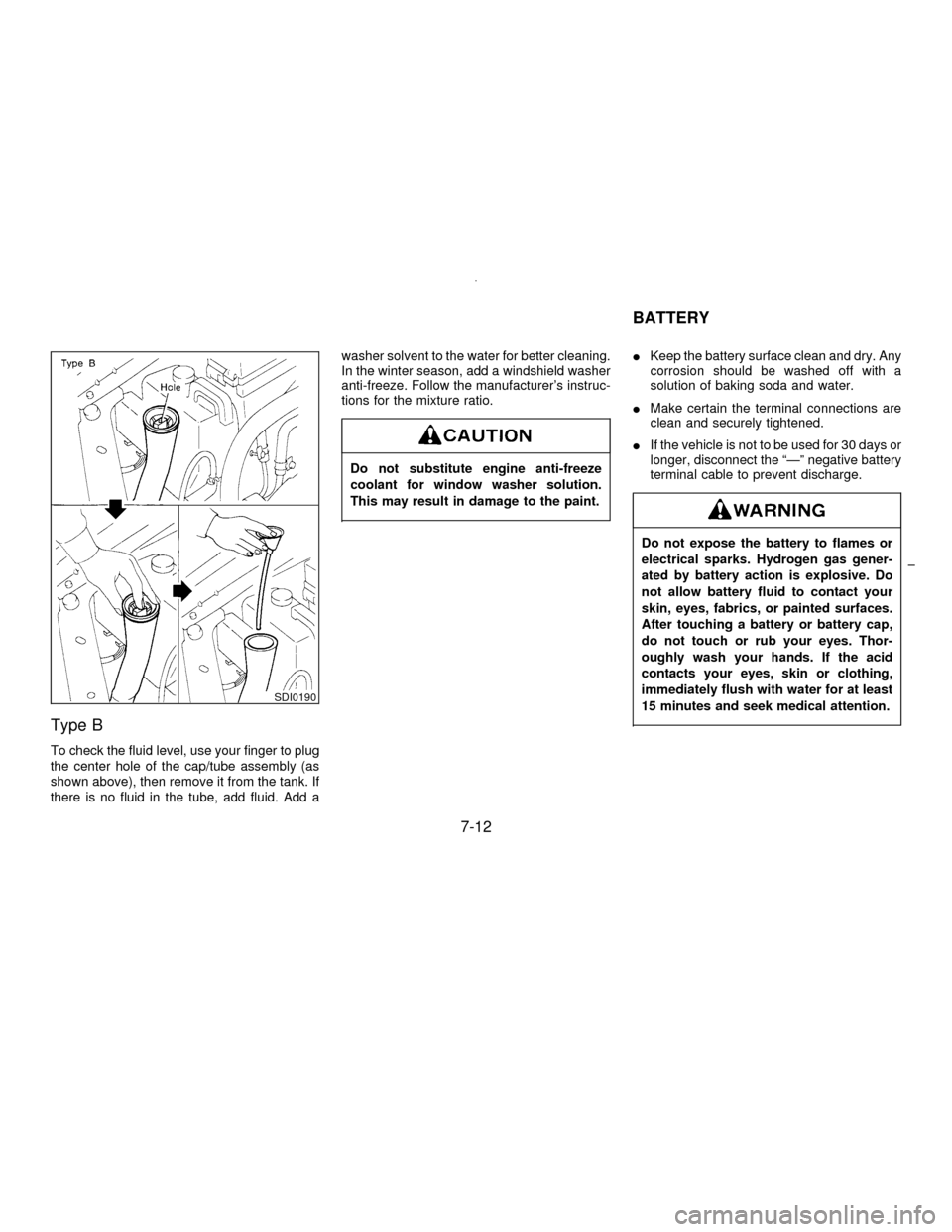1996 NISSAN MAXIMA coolant level
[x] Cancel search: coolant levelPage 118 of 197

is missing or loose, or the cooling fan
does not run, stop the engine.
7. After the engine cools down, check the
coolant level in the reservoir tank with the
engine running. Add coolant to the reservoir
tank if necessary. Have your vehicle re-
paired at the nearest NISSAN dealer.When towing your vehicle, all State (Provincial
in Canada) and local regulations for towing
must be followed. Incorrect towing equipment
could damage your vehicle. Towing instruc-
tions are available from your NISSAN dealer.
Local service operators will generally be famil-
iar with the applicable laws and procedures for
towing. To assure proper towing and to pre-
vent accidental damage to your vehicle, NIS-
SAN recommends that you have a service
operator tow your vehicle. It is advisable to
have the service operator carefully read the
following precautions.
IWhen towing, make sure that the
transmission, axles, steering system
and power train are in working condi-
tion. If any unit is damaged, a dolly
must be used.
IWhen towing with the front wheels on
the ground:
Turn the ignition key to the ªOFFº
position and secure the steering
wheel in a straight-ahead position
with a rope or similar device. Never
place the ignition key in the ªLOCKºposition. This will result in damage to
the steering lock mechanism.
Move the gearshift lever to the neutral
(ªNº position).
On automatic transmission models,
to move the shift lever to the Neutral
position, turn the ignition key to the
ªOFFº or ªACCº position. After mov-
ing the shift lever to the Neutral posi-
tion, be sure to turn the ignition key
to the ªOFFº position.
IWhen towing with the rear wheels on
the ground, release the parking
brake.
On automatic transmission models,
to move the shift lever to the Neutral
(ªNº position), turn the ignition key to
the ªOFFº or ªACCº position. After
moving the shift lever to the Neutral
position, be sure to turn the ignition
key to the ªOFFº position.
IAttach safety chains for all towing.
TOW TRUCK TOWING
5-9
Z01.2.1/A32-DX
Page 131 of 197

The engine cooling system is filled at the
factory with a high-quality, year-round, anti-
freeze coolant solution. The anti-freeze solu-
tion contains rust and corrosion inhibitors,
therefore additional cooling system additives
are not necessary.
When adding or replacing coolant, be
sure to use only an ethylene glycol anti-
freeze with the proper mixture ratio of
50% anti-freeze 50% softwater.
Outside temperature
down toAnti-
freezeSoft water
ÉC ÉF
þ35 þ30 50% 50%
The use of other types of coolant solutions
may damage your cooling system.
The radiator is equipped with a pressure
cap. Use a NISSAN genuine cap or its
equivalent when replacement is required.
Never remove the radiator cap when the
engine is hot. Serious burns could be
caused by high pressure fluid escaping
from the radiator.Wait until the engine and radiator cool
down. See precautions in ªIf Your Vehicle
Overheatsº found in the ªIn case of emer-
gencyº section.
CHECKING ENGINE COOLANT
LEVEL
With coolant reservoir
Check the coolant level in the reservoir tank
when the engine is cold. If the coolant level is
below ªMINº, add coolant up to the ªMAXº
level. If the reservoir tank is empty, check the
coolant level in the radiatorwhen the engine
is cold.If there is insufficient coolant in the
radiator, fill the radiator with coolant up to the
filler opening and also add it to the reservoir
tank up to the ªMAXº level.
If the cooling system frequently requires
SDI0113
ENGINE COOLING SYSTEM
7-4
Z01.2.1/A32-DX
Page 132 of 197

coolant, have it checked by your NISSAN
dealer.
CHANGING ENGINE COOLANT
IMajor cooling system repairs should be
performed by your NISSAN dealer. The
service procedures can be found in the
appropriate NISSAN Service Manual.IImproper servicing can result in reduced
heater performance and engine overheat-
ing.
ITo avoid the danger of being scalded,
never change the coolant when the
engine is hot.
INever remove the radiator cap when
the engine is hot. Serious burns
could be caused by high pressure
fluid escaping from the radiator.
1. Open the radiator cap and drain plug.
2. Open the drain plug on the engine block.
3. Flush the cooling system by running fresh
water through the radiator.
4. Close the radiator drain plug and the drain
plug on the engine block securely.
5. See the ªTechnical informationº section for
cooling system capacity. Fill the radiator
slowly with the proper mixture of coolant
and water. Fill the reservoir tank up to the
ªMAXº level. Then install the radiator cap.
SDI0114
7-5
Z01.2.1/A32-DX
Page 133 of 197

6. Start the engine, and warm it up until the
radiator fan operates. Then race the engine
2 or 3 times under no load. Watch the
coolant temperature gauge for signs of
overheating.
7. Stop the engine. After it completely cools
down, refill the radiator up to the filler
opening. Fill the reservoir tank up to the
ªMAXº level.
8. Check the radiator drain plug and the drain
plug on the engine block for any sign of
leakage.CHECKING ENGINE OIL LEVEL
1. Park the vehicle on a level surface and
apply parking brake.
2. Run the engine until it reaches operating
temperature.
3. Turn off the engine.Wait more than 5
minutes for the oil to drain back into the
oil pan.
4. Remove the dipstick and wipe it clean.
Reinsert it all the way.
SDI0138SDI0115
ENGINE OIL
7-6
Z01.2.1/A32-DX
Page 139 of 197

Type B
To check the fluid level, use your finger to plug
the center hole of the cap/tube assembly (as
shown above), then remove it from the tank. If
there is no fluid in the tube, add fluid. Add awasher solvent to the water for better cleaning.
In the winter season, add a windshield washer
anti-freeze. Follow the manufacturer's instruc-
tions for the mixture ratio.
Do not substitute engine anti-freeze
coolant for window washer solution.
This may result in damage to the paint.
IKeep the battery surface clean and dry. Any
corrosion should be washed off with a
solution of baking soda and water.
IMake certain the terminal connections are
clean and securely tightened.
IIf the vehicle is not to be used for 30 days or
longer, disconnect the ªÐº negative battery
terminal cable to prevent discharge.
Do not expose the battery to flames or
electrical sparks. Hydrogen gas gener-
ated by battery action is explosive. Do
not allow battery fluid to contact your
skin, eyes, fabrics, or painted surfaces.
After touching a battery or battery cap,
do not touch or rub your eyes. Thor-
oughly wash your hands. If the acid
contacts your eyes, skin or clothing,
immediately flush with water for at least
15 minutes and seek medical attention.
SDI0190
BATTERY
7-12
Z01.2.1/A32-DX
Page 165 of 197

head restraints move up and down smoothly
and that the locks (if equipped) hold securely
in all latched positions.
Seat beltsCheck that all parts of the seat belt
system (e.g. buckles, anchors, adjusters and
retractors) operate properly and smoothly, and
are installed securely. Check the belt webbing
for cuts, fraying, wear or damage.
Accelerator pedalCheck the pedal for
smooth operation and make sure the pedal
does not catch or require uneven effort. Keep
the floor mats away from the pedal.
Clutch pedal*Make sure the pedal operates
smoothly and check that it has the proper free
play.
BrakesCheck that the brakes do not pull the
vehicle to one side when applied.
Brake pedal and booster*Check the pedal
for smooth operation and make sure it has the
proper distance under it when depressed fully.
Check the brake booster function. Be sure to
keep floor mats away from the pedal.
Parking brake*Check that the lever has the
proper travel and make sure that the vehicle is
held securely on a fairly steep hill when only
the parking brake is applied.
Automatic transaxle ªParkº mechanismCheck that the brake pedal must be depressed
for the selector lever to be moved from the ªPº
position. On a fairly steep hill check that the
vehicle is held securely with the selector lever
in the ªPº position without applying any brakes.
UNDER THE HOOD AND VEHICLE
The maintenance items listed here should be
checked periodically (e.g. each time you check
the engine oil or refuel).
Windshield washer fluid*Check that there is
adequate fluid in the tank.
Engine coolant level*Check the coolant level
when the engine is cold.
Radiator and hosesCheck the front of the
radiator and clean off any dirt, insects, leaves,
etc., that may have accumulated. Make sure
the hoses have no cracks, deformation, dete-
rioration or loose connections.
Brake and clutch fluid levels*Make sure that
the brake and clutch fluid levels are between
the ªMAXº and ªMINº lines on the reservoir.
Battery*Check the fluid level in each cell. It
should be between the ªMAXº and ªMINº lines.
Engine drive belts*Make sure that no belt is
frayed, worn, cracked or oily.
Engine oil level*Check the level on thedipstick after parking the vehicle on a level
spot and turning off the engine. Be sure to wait
a few minutes to allow the oil to drain back into
the sump.
Power steering fluid level* and linesCheck
the level in the reservoir tank with the engine
off. Check the lines for proper attachment,
leaks, cracks, etc.
Automatic transaxle fluid level*Check the
level on the dipstick after putting the selector
lever in ªPº with the engine idling.
Exhaust systemMake sure there are no
loose supports, cracks or holes. If the sound of
the exhaust seems unusual or there is a smell
of exhaust fumes, immediately locate the
trouble and correct it. (See the carbon monox-
ide warning in the ªStarting and drivingº sec-
tion)
UnderbodyThe underbody is frequently ex-
posed to corrosive substances such as those
used on icy roads or to control dust. It is very
important to remove these substances, other-
wise rust will form on the floor pan, frame, fuel
lines and around the exhaust system. At the
end of winter, the underbody should be thor-
oughly flushed with plain water, being careful
to clean those areas where mud and dirt may
accumulate. See the ªAppearance and interior
careº section for additional information.
8-4
Z01.2.1/A32-DX
Page 171 of 197

EXPLANATION OF MAINTENANCE
ITEMS
Additional information on the following
items with ª*º is found in the ªDo-it-
yourself operationsº section.
Emission control system
maintenance
Drive belts*Check drive belts for wear, fray-
ing or cracking and also for proper tension.
Replace the drive belts if found damaged.
Air cleaner filterUnder normal driving condi-
tions, the air cleaner filter should be replaced
in accordance with the maintenance schedule.
However, driving the vehicle in dusty areas
may cause more rapid clogging of the element.
Consequently, the element may have to be
replaced more frequently.
Vapor linesCheck vapor lines and connec-
tions for failure or looseness. If leaks are
found, replace them.
Fuel linesCheck the fuel hoses, piping and
connections for leaks, looseness or deteriora-
tion. Replace any parts if they are damaged.
Fuel filterIf the vehicle is operated under
extremely adverse weather conditions or in
areas where ambient temperatures are either
extremely low or extremely high, the filtermight become clogged. In such an event,
replace the filter immediately.
Engine coolant*Drain and flush the cooling
system.
Engine oil & oil filter*Under normal driving
conditions, the engine oil and oil filter should
be replaced in accordance with the mainte-
nance schedule. However, under severe driv-
ing conditions, they may have to be replaced
more frequently.
Spark plugs*Replace with new plugs having
the correct heat range.
Intake & exhaust valve clearanceCheck and
adjust the valve clearance.
Chassis and body maintenance
Brake lines & cablesCheck the brake lines
and hoses (including brake booster vacuum
hoses, connections & check valve) and park-
ing brake cables for proper attachment, leaks,
cracks, chafing, abrasion, deterioration, etc.
Brake pads, discs, drums & liningsCheck
these and the other neighboring brake compo-
nents for wear, deterioration and leaks. Under
severe driving conditions, they may have to be
inspected more frequently.
Manual & automatic transaxle gear oil*Check the oil level and visually inspect for
signs of leakage.
Under severe driving conditions, the oil should
be replaced at the specified interval.
Steering gear & linkage, axle & suspension
parts, and drive shaft bootsCheck for dam-
age, looseness and leakage of oil or grease.
Under severe driving conditions, more fre-
quent inspection should be performed.
Steering linkage ball joints & front suspen-
sion ball jointsCheck the ball joints for dam-
age, looseness and grease leakage.
Exhaust systemVisually check the exhaust
pipes, muffler, and hangers for proper attach-
ment, leaks, cracks, chafing, abrasion, dete-
rioration, etc. Under severe driving conditions,
inspection should be performed more fre-
quently.
Air bag systemCheck the air bag system
components for proper attachment, damage,
deformities, cracks rust, etc. Work around and
on the air bag system should be done by an
authorized NISSAN dealer.
8-10
Z01.2.1/A32-DX
Page 173 of 197

The following are approximate capacities. The actual refill capacities may be a little
different. When refilling, follow the procedure instructed in the ªDo-it-yourself operationsº
section to determine the proper refill capacity.
Capacity (Approximate)
Recommended
specifications US
measureImp
measureLiter
Fuel 18-1/2 gal 15-3/8 gal 70Unleaded gasoline with an octane rating
of at least 91 AKI (RON 96)
Engine oil (Refill)
With oil filter 4-1/4 qt 3-1/2 qt 4.0IAPI SG or SH and Energy Conserving
II*1, *2
IAPI Certification Mark*1, *2 Without oil filter 3-7/8 qt 3-1/4 qt 3.7
Cooling system
With reservoir 9 qt 7-1/2 qt 8.5
Anti-freeze coolant
(Ethylene glycol base)
Reservoir 7/8 qt 3/4 qt 0.8
Manual transmission gear oilÐ Ð Ð API GL-4*3
Automatic transmission fluid
Refill to the proper oil level according
to the instructions in the ªDo-it-
yourself operationsº section.Nissan Matic ªDº (Continental U.S. and
Alaska) or Genuine Nissan Automatic
Transmission Fluid (Canada).*4
Power steering fluid Type DEXRON
TMII or equivalent
Brake and clutch fluidGenuine Nissan Brake Fluid or equiva-
lent*3
DOT 3 (US FMVSS No. 116)
Multi-purpose greaseÐ Ð Ð NLGI No. 2 (Lithium soap base)
Air conditioning system refrigerantÐ Ð Ð HFC-134a (R-134a)
Air conditioning system lubricants Ð Ð ÐNissan A/C System Oil
Type S or exact equivalent
*1: For further details, see ªEngine oil and oil filter recommendationº.
*2: For further details, see ªRecommended SAE viscosity numberº.
*3: For more information regarding suitable fluids, contact a NISSAN dealer.
*4: Dexron III/Mercon
or equivalent may also be used. Outside the continental United States and Alaska contact a NISSAN dealer for
more information regarding suitable fluids, including recommended brand(s) of DexronIII/Merconor DexronIIE/MerconAutomatic Transmission Fluid.
FUEL RECOMMENDATION
Unleaded premium gasoline with an octane
rating of at least 91 AKI (Anti-Knock Index)
number (Research octane number 96)
If unleaded premium gasoline is not avail-
able, unleaded regular gasoline with an
octane rating of at least 87 AKI (Research
octane number 91) can be used.
However, for maximum vehicle perfor-
mance, the use of unleaded premium gaso-
line is recommended.
Using a fuel other than that specified
could adversely affect the emission con-
trol devices and systems, and could
also affect the warranty coverage.
Under no circumstances should a
leaded gasoline be used, since this will
damage the three-way catalyst.
Reformulated Gasoline
Some fuel suppliers are now producing refor-
mulated gasolines. These gasolines are spe-
cially designed to reduce vehicle emissions.
CAPACITIES AND
RECOMMENDED
FUEL/LUBRICANTS
9-2
Z01.2.1/A32-DX